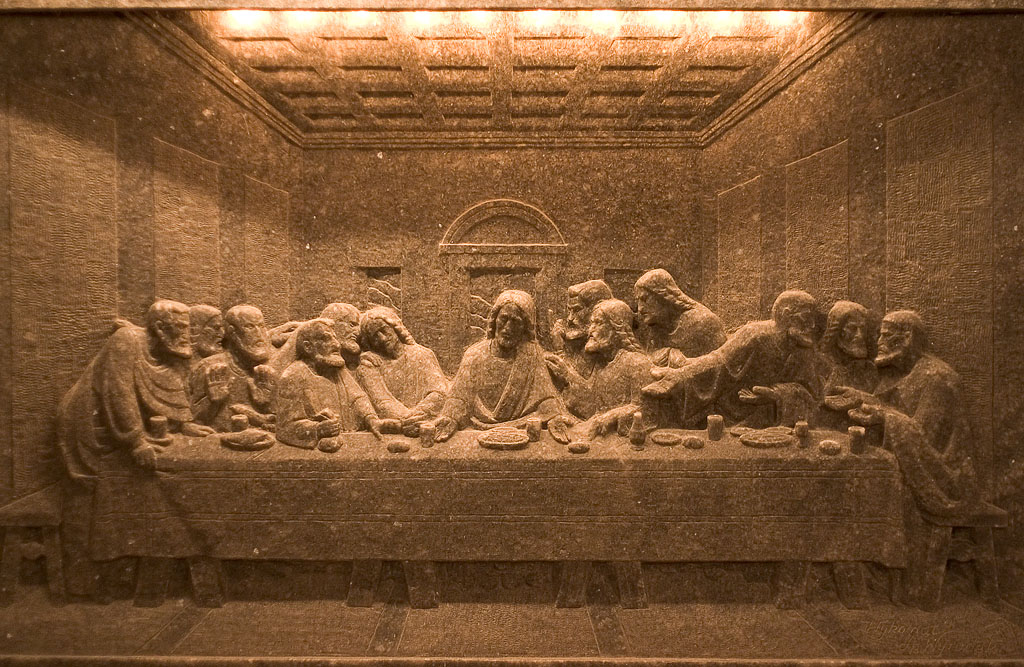 |
| Sculpture in the Chapel of St. Kinga in the Wieliczka Salt Mine |
After exploring Old Town in Kraków, we took a bus trip out to see the Wieliczka Salt Mine. The Wieliczka Salt Mine has been in operation from the 13th century
(although at this point there is no salt being mined; miners work to
maintain the structures of the mine). Legend has it that the salt in
the mine was the dowry of Princess Kinga, who became the patron saint of
salt miners. The mine is enormous --
300 km over 9 levels (but the tours only include the upper three
levels). The tour includes displays of how salt was mined as well as
the amazing sculptures created from salt by the miners.
The mine contains a number of chapels, but the St. Kinga chapel is the most impressive. It is a huge chamber, full of detailed sculptures and bas-reliefs made from rock salt (including a replica of The Last Supper and a statue of Pope John Paul II). The sculptures in this chapel were made over the course of 30 years by just a few of the miners in their spare time. The artistry is exquisite. You can see more of the sculptures here.
The mine contains a number of chapels, but the St. Kinga chapel is the most impressive. It is a huge chamber, full of detailed sculptures and bas-reliefs made from rock salt (including a replica of The Last Supper and a statue of Pope John Paul II). The sculptures in this chapel were made over the course of 30 years by just a few of the miners in their spare time. The artistry is exquisite. You can see more of the sculptures here.
 |
| The Last Supper carved in salt in the Chapel of St. Kinga via |
 |
| A chandelier in the Chapel of St. Kinga in the Wieliczka Salt Mine |
The sculpture below is also made of salt, and the glowing heart is a special kind of translucent salt, lit from within.
 |
| Another sculpture in the Chapel of St. Kinga in the Wieliczka Salt Mine |
 |
| Detail of the carving in the Chapel of St. Kinga |
I marveled at the detail and precision of the carving. Just think, this was done by miners in their spare time -- men who, most likely, did not have extensive, formal training in art. The artistic impulse cannot be denied, even when one works long days underground, mining salt.
In addition to being a source of salt and an artistic creation, the mine is also used as a health spa. Our guide told us that the air in the mine is especially good for people with allergies or other respiratory ailments, who do special exercises in the mine, one of which is singing.
 |
| The Józef Piłsudski Grotto in the Wieliczka Salt Mine |
There were a number of underground lakes in the Wieliczka Salt Mine; this one is a comparatively small lake. Our guide told us that people used to be able to take a (very short) boat ride through the tunnel to get to this lake, while an orchestra played music on the bank of the lake. These trips were discontinued after a tragic accident involving a group of soldiers in WWI. The soldiers stood up in their boat to dance to the music, and the boat capsized. The salt water of the lake is such that people float, so they couldn't drown, but they also couldn't get out from under the capsized boat, so they suffocated.
Although drowning is not a real risk in the mine, miners faced a number of dangers, including a risk of explosion from igniting underground gas pockets. They also had to haul the salt up slippery and irregular stairs cut into the salt, so falling injuries were not uncommon.
 |
| Wieliczka Salt Mine (Kraków, Poland) |
It turns out salt mines can have a haunting beauty. Check out these amazingly beautiful photos of salt mines (thanks to Barbara Dawes Irish for the link) and this preview for "Salt", a documentary about a photographer's journey to Lake Eyre in Central Australia (thanks to Roberta Buckberg for this recommendation).

No comments:
Post a Comment